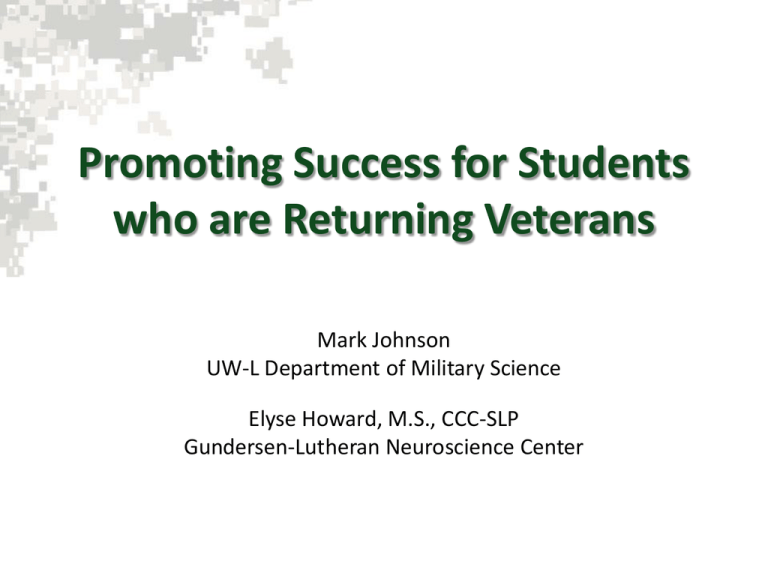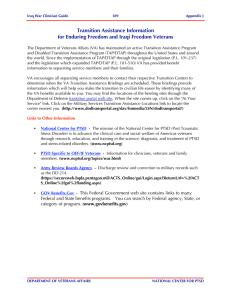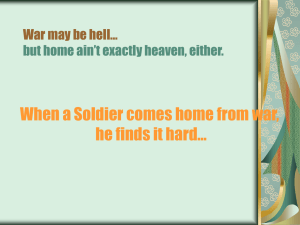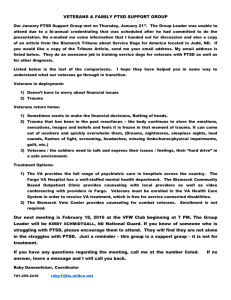Promoting Success for Students who are Returning Veterans
advertisement

Promoting Success for Students who are Returning Veterans Mark Johnson UW-L Department of Military Science Elyse Howard, M.S., CCC-SLP Gundersen-Lutheran Neuroscience Center What’s on Tap • • • • • Short history lesson Military populations on campus UW-L resources for student veterans UW-L military call-up policy Combat stress, Traumatic Brain Injury (TBI) & Post-Traumatic Stress Disorder (PTSD) • Recommendations Never More Timely Than Now. . . “Not since World War II has so much been asked of our Soldiers. Almost every Wisconsin county can name a student, a mother, father, son or daughter, who is part of the 32nd.” —Gov. Jim Doyle Deployment ceremony for the Wisconsin National Guard’s 32d Brigade Dane County Memorial Coliseum, Madison February 17, 2009 How We Arrived Here from There • The “G.I. Bill of Rights” – Wartime-era legislation • Acts of 1944 and 1952 authorized education benefits for veterans who served in WWII and Korea – Veterans Readjustment Benefits Act of 1966 • Extended benefits to all qualified active-duty veterans (not just those who serve in wartime) – Montgomery G.I. Bill of 1985 • Extended benefits to members of the National Guard & Reserve – From 1945 through the present day, more than 21 million veterans have used education benefits • End of the draft and transition to all-volunteer force, 1973 – To attract high-quality recruits, education benefits became increasingly more lucrative • Post-Vietnam restructuring of Army forces – Goal was to avoid the disconnect between American society and the American armed forces that occurred during the Vietnam War – Key units and capabilities placed in the Guard and Reserve – Necessitates mobilization of Guard/Reserve forces in times of conflict The Three On-Campus Military/Veteran Populations • Students who are discharged veterans – Former members of the Active, Guard, or Reserve forces – Some have served overseas, some not • Students who are currently serving in the National Guard or Reserve – Some were UW-L students prior to their mobilization and have returned to campus (many will do so in Fall Semester 2010) – Some have served overseas, some not • Students who are Army ROTC cadets – Let me know if a student-cadet uses ROTC as an excuse. . . • Note that a student could be a member of all three populations simultaneously • Also note that an increasing percentage of veterans are female – About 11% of American service members in Iraq/Afghanistan (more than 180,000 to date) – Due to the changing nature of combat, for the first time ever female veterans may experience PTSD Resources for UW-L Student-Veterans • Registration & Records – Veteran Benefits Coordinator: Sharon Lehrke • Transfer credits for military service – All veterans receive a service transcript endorsed by the American Council on Education – University policy dictates amount/type of credits accepted at UW-L – Department of Military Science waives requirement for 100- and 200-level courses for all veterans • UW-L Student Veterans’ Club – President: Brandon Powers – VP/Secretary: Daryl Thomas – Faculty advisor: ? UW-L Military Call-up Policy • http://www.uwlax.edu/Records/VeteransCertification/Milit ary%20call%20up%20policy.htm • The call-up policy covers procedures for – – – – Fee refunds Financial aid Academic records Re-entry to UW-L upon completion of active duty • Applicable only to students in the Guard/Reserve who are called to active duty – Does not cover students who voluntarily enlist – Does not cover students in the Guard/Reserve who must complete their two-week annual training requirements during an academic term Combat Stress The mental, emotional or physical tension, strain, or distress resulting from exposure to combat and combat-related conditions. Combat Stress Behaviors • Positive Combat Stress Behaviors – Heighten Alertness – Strength / Endurance – Positive Unit Bonding • Misconduct Stress Behaviors – Breach of unit orders – Breach of the Law of Land Warfare • Battle Fatigue – Irritability, Anger, Rage – Inattention – Impaired Duty Performance • Post-Traumatic Stress Disorder (PTSD) – Can happen to any veteran Traumatic Brain Injury (TBI) and Post-Traumatic Stress Disorder (PTSD) Facts about traumatic brain injuries • Brain injury is the “signature wound” of combat operations in Iraq and Afghanistan • Mild cases of TBI are relatively easy to miss and are often not treated correctly • Professionals may minimize the damage & effects of TBI Mild TBI: Is it serious? • Mild TBI involves a blow to the head that may cause a momentary loss of consciousness • Any time the brain suffers a violent force or movement, the soft, floating brain is slammed against the skull’s uneven and rough interior, even if it’s a mild impact • The impact on the brain’s neurological circuits is often subtle, yet significant Causes of TBI for military personnel • A blow to the head (falls, MVAs, training accidents) • A blast exposure (leading cause of TBI for military personnel in war zones) • Gunshot wounds TBI Symptoms – what to look for Physical symptoms – Headache – Feeling tired all the time, having no energy of motivation – Dizziness, light-headedness, or loss of balance – Blurred vision or eyes that tire easily – Vomiting/nausea – Sensitivity to lights, sounds, or distractions – Change in sleep patterns (sleeping a lot more, or having a difficult time sleeping) – Ringing in ears (tinnitus) TBI Symptoms – what to look for Cognitive symptoms – Difficulty remembering, concentrating, or making decisions (memory problems) – Slowness in thinking, speaking, acting, or reading (processing) – Getting lost, easily confused, or overwhelmed – Diminished attention span – Inability to focus on a task (attending) – Easily distracted – Difficulty problem-solving (organization, reasoning) – Inability to plan a sequence of complex movements needed to complete multi-stepped tasks – Loss of flexibility in thinking – Persistence of a single thought (perseveration) – Inability to express language (word-finding) TBI Symptoms – what to look for Social, emotional, and behavioral symptoms – – – – – – – – – – Changes in personality (sudden mood swings) Irritability (lose temper/short fuse) heightened arousal (anxiety) Depression pragmatic language difficulties (social awareness) Anosognosia Lassitude (lethargy, fatigue, weariness) Loss of spontaneity in interacting with others (initiation) Emotionally labile Changes in social behavior from pre-morbid state (difficulty inhibiting behavior, impulsive) Post Traumatic Stress Disorder • A severe form of post combat stress • Signs and symptoms of PTSD typically begin within three months of a traumatic event • Many service members do not seek treatment for psychological illnesses because they fear it will harm their careers • Untreated, PTSD and depression can lead to cascading problems, such as drug use, marital problems, unemployment and even suicide Pervasiveness of PTSD • According to the VA, PTSD occurs – in about 6% to 11% of veterans of the Afghanistan war – in about 12% to 20% of veterans of the Iraq war • A 2008 study found that one in five vets returning from Iraq and Afghanistan experience symptoms of PTSD or major depression • Personnel deploying to combat receive mental health screenings pre-deployment, upon return, and 6 months after return – Still might not be adequate PTSD Symptoms – what to look for Re-experiencing the traumatic event – Intrusive, upsetting memories of the event – Flashbacks, or reliving the traumatic event for minutes or even days at a time – Upsetting dreams about the traumatic event – Feeling of intense distress when reminded of the event – Intense physical reactions to reminders of the event (e.g., pounding heart, rapid breathing, nausea, muscle tension, sweating) PTSD Symptoms – what to look for Avoidance and emotional numbing – Avoiding activities, places, thoughts, or feelings that remind you of the traumatic event – Inability to remember important aspects of the trauma – Loss of interest in activities and life in general – Feeling detached from others and emotionally numb – Sense of a limited future (you don’t expect to live a normal lifespan, get married, have a career) PTSD Symptoms – what to look for Emotional arousal – Difficulty falling or staying asleep – Irritability or outbursts of anger – Difficulty concentrating – Hypervigilence (on constant “red alert”) – Feeling jumpy or easily startled PTSD Symptoms – what to look for Other common symptoms of PTSD – Anger and irritability – Guilt, shame, or self-blame – Substance abuse – Depression and hopelessness – Suicidal thoughts and feelings – Feeling alienated and alone – Feelings of mistrust and betrayal – Headaches, stomach problems, chest pain PTSD and medical illnesses • Studies of war veterans have demonstrated a link between PTSD and the development of medical illnesses, including: – Cardiovascular disease – Chronic pain – Autoimmune diseases, such as rheumatoid arthritis and thyroid disease – Musculoskeletal conditions • A very common finding is having TBI concurrently with PTSD UW-L Student-Veterans & TBI/PTSD • The policies, procedures, and resources available through the university’s Disability Resource Services (are/should be/hopefully are) adequate to address the needs of student-veterans • The larger problem may be that studentveterans may not realize they need help. . . Recommendations for an even more “veteran friendly” campus • Appoint a faculty advisor for the Student Veterans’ Club • Schedule a veterans' information session each year as part of the university's freshman/new student orientation at the beginning of fall semester • Consider whether to amend the academic portion of the military call-up policy to cover Guardsmen/Reservists who must complete their two-week annual training requirement during a term • Grant all veterans academic credit for the university's 100- & 200level military science courses (8 credits total) in addition to whatever other credits the university deems appropriate • Ensure Disability Resource Services understands the unique needs of the university’s student-veteran population • Make information available to all faculty and staff on signs & symptoms of TBI and PTSD





